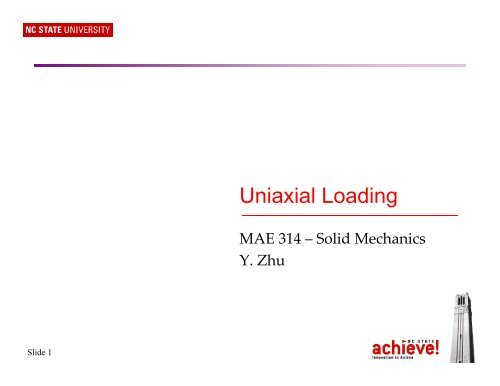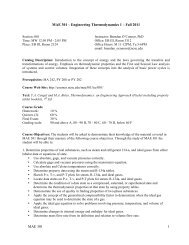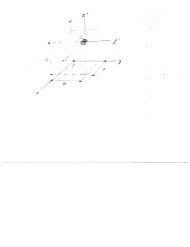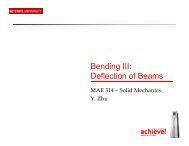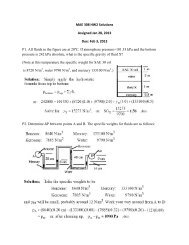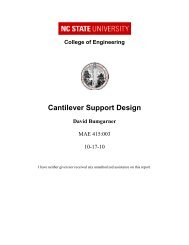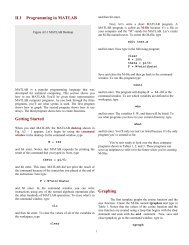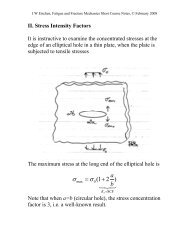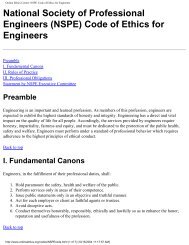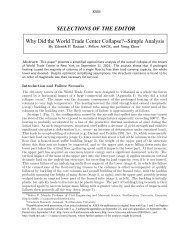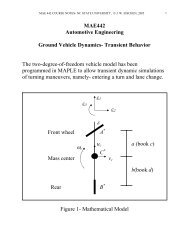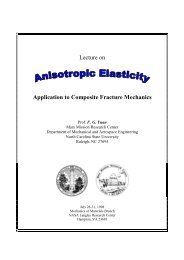Uniaxial Loading
Uniaxial Loading
Uniaxial Loading
- No tags were found...
You also want an ePaper? Increase the reach of your titles
YUMPU automatically turns print PDFs into web optimized ePapers that Google loves.
Deformations Under Axial <strong>Loading</strong>• Conditions– Solid bars, cables, coil springs, etc.– Axial tension or compression–Prismatic• Recall Hooke’s Law ( σ = Eε ) andPequations for stress ( σ = ) and strain ( ε = ).APδPL= E ⇒ δ =A L AEδLSlide 2 --- <strong>Uniaxial</strong> <strong>Loading</strong> ---
Deformations Under Axial <strong>Loading</strong> - cont’d• What about non-prismatic bars?– Discrete Changes: total change in lengthis simply the summation of the change inlength of each portion.δ = ∑iPLi E A i=i– Important: Each time the internalforce, area, or material changesyou need a new free-body diagram!δ =P 1L1P 2L2P 3L3++E A E A EA12 3Note: Misprint in textbook example 2.01 E = 29x10 6 psiiSlide 3 --- <strong>Uniaxial</strong> <strong>Loading</strong> ---
Example Problem 1• A single axial load of magnitude P = 58 kN is applied atend C of the brass rod ABC. Knowing that E = 105 GPa,determine the diameter d of portion BC for which h thedeflection of point C will be 3 mm.Slide 5 --- <strong>Uniaxial</strong> <strong>Loading</strong> ---
Slide 6 --- <strong>Uniaxial</strong> <strong>Loading</strong> ---
Statically Indeterminate Problems• Statically determinate structure – reactions and internal forces canbe determined uniquely from free-body diagram and equations ofequilibrium.• Statically indeterminate structure – there are more unknownreactions than equations of equilibrium.• Where do the other equations needed to solve the unknownreactions come from?– Equations of compatibility which are based on displacements.– Here is a easy method to determine how many compatibility equationsyou need for any given problem:• M = R – N• M = number of compatibility equations needed• R = number of unknown reactions (or internal stresses)• N = number of equilibrium equationsSlide 7 --- <strong>Uniaxial</strong> <strong>Loading</strong> ---
Statically Indeterminate Problems - cont’dR 1R 1R = 1:R 1R = 2:R 1 ,R 2RN = 1 : ΣF Y = R 1 –P = 0N = 1 : ΣF Y = R 1 –P–R 2 = 0M = 1 - 1 = 0M = 2 - 1 = 1R 2Statically indeterminate structureSlide 8 --- <strong>Uniaxial</strong> <strong>Loading</strong> ---
Example Problem 2• Two cylindrical rods, CD made of steel (E=29x10 6 psi) and AC madeof aluminum (E=10.4x10 6 psi), are joined at C and restrained by rigidsupports at A and D. Determine (a) the reactions at A and D, (b) thedefection of point C.Slide 9 --- <strong>Uniaxial</strong> <strong>Loading</strong> ---
Slide 10 --- <strong>Uniaxial</strong> <strong>Loading</strong> ---
Example Problem 3A rod of length L, cross-sectional area A 1 , and modulus of elasticityE 1 , has been placed inside a tube of the same length L, but of cross-sectional area A 2 and modulus of elasticity E 2 . what is thedeformation of the rod and tube when a force P is exerted on a rigidend plate as shown?Slide 11 --- <strong>Uniaxial</strong> <strong>Loading</strong> ---
Slide 12 --- <strong>Uniaxial</strong> <strong>Loading</strong> ---
Temperature Changes• Changes in temperature produce expansion or compression,which cause strain.εT = αΔT– α = coefficient of thermal expansion– ΔT = change in temperature– Sign convention: expansion is positive (+), contraction isnegative (-)• For a bar that is completely free to deform (one or both endsfree):δ= ε L =α(ΔT )LT TL )• In this case, there is thermal strain but no thermal stress!Slide 13 --- <strong>Uniaxial</strong> <strong>Loading</strong> ---
Temperature Changes - cont’d• Thermal stresses occur when the bar is constrained such thatit cannot deform freely.• In this case there is thermal stress but no thermal strain!• Statically Determinate Structures– Uniform ΔT in the members produces thermal strains but nothermal stresses.• Statically Indeterminate Structures– Uniform Δ T in the members produces thermal strains and/orthermal stresses.Slide 14 --- <strong>Uniaxial</strong> <strong>Loading</strong> ---
Example Problem 4• A rod consisting of two cylindrical portions AB and BC is restrained atboth ends. Portion AB is made of steel (E s =29x10 6 psi, α s =6.5x10 -6 / o F)and portion BC is made of brass (E b =17x10 6 psi, α b =10.4x10 -6 / o F).Knowing that the rod is initially unstressed, determine (a) the normalstresses induced in portions AB and BC by a temperature rise of 65 o F,(b) the corresponding deflection of point B.12 in1.25-in diameter15 in2.25-in diameterSlide 15 --- <strong>Uniaxial</strong> <strong>Loading</strong> ---
Slide 16 --- <strong>Uniaxial</strong> <strong>Loading</strong> ---
Example Problem 5• Knowing that a 0.02-in. gap exists when the temperature is 75 o F, determine(a) the temperature at which the normal stress in the aluminum bar will beequal to -11 ksi, (b) the corresponding exact length of the aluminum bar.Slide 17 --- <strong>Uniaxial</strong> <strong>Loading</strong> ---
Slide 18 --- <strong>Uniaxial</strong> <strong>Loading</strong> ---
• Example 2.4 in the bookExample Problem 6Slide 19 --- <strong>Uniaxial</strong> <strong>Loading</strong> ---
Slide 20 --- <strong>Uniaxial</strong> <strong>Loading</strong> ---


